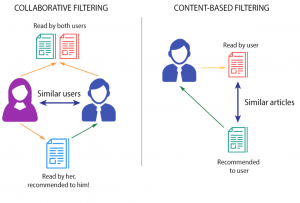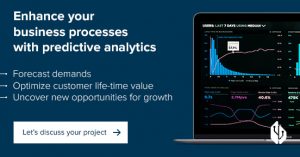Businesses across different industries face, however, similar obstacles on the road to success. Among such constraints are time-consuming manual tasks, poor conversion rate, low productivity, etc.
As Gartner says, “Data scientists hold the key to unveiling better solutions to old problems.” There are lots of data science techniques that can be successfully used for building custom systems to overcome niche-specific challenges. Here are the 4 most popular and valuable ones.
1. Revamp Business Operations with Machine Learning
Out of the buzzwords related to ‘learning’, machine learning (ML) continues to gain impetus. ML-based solutions can already solve an array of problems. Data scientists train more and more complicated ML algorithms to learn by trial and error. Machines learn while processing feedback, generating business predictions, exercising motion control, and on and on.
As the Google Trends chart shows, engagement with data science and ML is steadily on the increase over the past 5 years.

Businesses seek to adopt ML-based solutions to derive more value from traditional activities.
- Increase customer engagement, e.g., by introducing intelligence customer service or robots that can partially take over from human assistants.
- Streamline complex routine tasks, e.g., to use neural network-based OCR for paper document workflows.
- Gain an edge over competitors by improving general productivity that allows employees to focus more on essential strategic goals and tasks.
The output of an ML-based approach depends inextricably on data-crunching power and the quality of data used for training. When launching, say, a computer vision project, it is vital to cooperate with computer vision engineers to gather relevant and comprehensive datasets.
2. Deep Learning for Unequaled Customer Experience
As a subset of ML, deep learning often refers to deep neural networks (NNs) that consist of a large number of layers of architecture. Such are ResNet, Inception, and other types of networks. Training an NN to meet various challenges, engineers deal with multiple issues in the field of mathematical analysis, optimization, and numerical methods. The process of implementation presents difficulties as well.
We live in a multidimensional world. To benefit from using data science for business, engineers need datasets for training deep learning models as varied as possible. Consequently, it requires a lot of computational power to train a model with complicated architecture.
Widely applied in computer vision, the technology demonstrates impressive results in replicating human vision. The Amazon Go store is an example of the advanced use of this technology. Numerous in-store cameras are able to determine when a customer takes an item off the shelves or put it back. The cameras also track customer movements around the store and ensure the correct functioning of a billing app.
Additionally, deep learning technique can facilitate solving cybersecurity issues. Today’s hacker attacks grow more and more sophisticated. But deep learning-based algorithms can be incredibly good at identifying deviations from normal patterns. This model first singles out what is normal and then compares abnormal events with the norm. The approach is known as unsupervised learning. It enables algorithms to detect more threats than those they have been trained on.
Introducing computer vision into workflow processes allows automating routine and repetitive tasks. It can also help businesses ensure unrivaled customer experience and adopt more secure resource-saving approaches.
3. Predictive Analytics for Data-Driven Decisions
Modern information space provides zillions of business development options, strategies, and decisions. Even the smartest individuals are unable to analyze and take into account all the data. In this instance, some stats, analysis, and machine learning techniques come into place to enable omniscient predictive analytics.
Predictive models deal with big data to generate informed predictions and revamp business decision-making processes. Depending on a company, business data can include transactions information, marketing metrics, user profiles, customer feedback, etc.
According to Forbes, 82% of enterprises focus on predictive analytics services and BI as a part of a tech-driven business transformation. Little wonder, since predictive analytics assists organizations and industries in many ways. Here is just a handful of examples:
- In the automotive industry – i.e., for connected vehicles and equipment – it facilitates equipment maintenance by analyzing sensors data and predicting breakdowns.
- The financial sector can rely on this technique for credit risk management.
- It can help healthcare specialists choose and prescribe an optimal treatment based on patient personal data and medical records.
It is noteworthy that human involvement is essential here. It would be misleading to completely rely on technology in cases involving potential risks to life and health. Advanced technologies and human specialists should work hand in hand to maximize the outcome of the efforts.
4. Recommendation Engine to Improve Brand Image
Another technique is predefined by shopping as a necessity for everyone. Recommendation engines can offer informed suggestions on goods and entertainments, uncover new opportunities for audience growth and promotion via blogging.
Such systems deliver recommendations based on historical data on user interactions or attributes of an item or a user. Accordingly, there are two types of algorithms used for recommenders: collaborative filtering and content-based models. But both can be combined in one engine.

Source: www.marutitech.com
For instance, it may seem that Amazon unmistakably knows what item a user wants to buy. It is the output of item-to-item collaborative filtering. Netflix’s engine uses content, i.e., movies, watched by a user to provide similar movie recommendations.
This technique enables time- and resource-saving approaches for business growth. It can help create a distinctive brand image and significantly improve the conversion rate.
This list of techniques allowing industry representatives to make productive use of data science for business is by far not complete. The choice of one or another approach depends on the type of data, the scale of a project, business needs and challenges. The overview of the 4 techniques sheds some light on using data science for business. However, certain specifics may beсome clear only during the development process. So, it’s the right time to launch a new data-driven project.
Work with InData Labs on your Predictive Analytics project.


